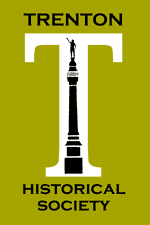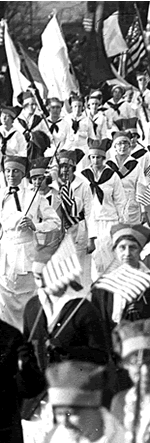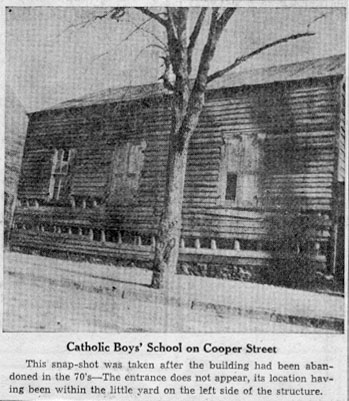



TRENTON IN BYGONE DAYS
By John J. Cleary
Sunday Times-Advertiser, July 21, 1935
Having an errand on Cooper Street
below Market a few days ago, I took a look around and surveyed a neighborhood
that was once quite familiar. Pretty
much all the old residents have removed to other sections or have passed from
life. I chanced, however, to meet
Lewis Smith and learned to my surprise that he still occupies the old family
home at No. 151. It was erected by
his father, William H. Smith, about sixty years ago, together with several
other comfortable dwellings of brick in the immediate neighborhood. William H. Smith was a prosperous newsdealer,
dividing the morning newspaper routes with George Fitzgeorge, one covering
the territory north of the creek and the other serving all of South Trenton.
They were both very agreeable, dependable gentlemen, both of English
birth and both residents of the Third Ward.
Mr. Smith's two sons, Frank and Lewis, as boys, helped out with delivery
of the old True American and the State Gazette and when they grew up established
independent routes of their own.
Smith, Sr., showed his enterprise
by developing Cosey Place, a small artery of travel and snug homes which runs
between Cooper and Lamberton Streets immeditely north of the, Pennsylvania
Railroad.
Is Lewis Smith the only one of
the old-time residents of Cooper Street still remaining? Not quite.
The Mitchell family settled there before the arrival of the Smiths,
I think, and two members of the second generation, the estimable Misses' Mary
and Jane Mitchell, are still occupants of the old homestead, near Market Street.
--------------------
Among those whom I remember on
Cooper Street in the long ago were the Ruhlmans, the pioneer being Professor
Rudolph Ruhlman of local band fame. His
house was on the west side of the street.
His two sons, John and Fred, also became professional musicians. Cassel R., a grandson, is a lawyer but is a
resident elsewhere than on Cooper Street.
The Crawford family, was also prominent,
living across the way from the Ruhlmans. Thomas Crawford, Sr., was a blacksmith originally but late in life
became an undertaker and was succeeded in his business by several of his numerous
boys.
Who recalls "Jerry" Kelly,
Who preceded Mr. Crawford as an undertaker and who was also an upholsterer
and lived opposite the rear of old St. John's Church? It was my proud privilege after funerals to
ride one of "Jerry's" horses back to the livery stable from which
it was hired.
The children who attended St. John's
parish school entered from Cooper Street and enlivened the neighborhood before
and after school hours. Besides the
classrooms in the basement of St John's Church for boys and girls, a frame
one-room stove-heated structure had been raised a short distance north of
the church, which accomodated the older boys under care of a master until
St. John's School on Lamberton Street was opened.
I once told the story of this ancient school and the teachers who presided
within its walls, those old-time pedagogues finding it by no means easy to
maintain discipline over a sturdy mischievous bunch of halfgrown youths.
Maybe we will return to the subject on some later occasion, recalling
snowball fights, stone fights and other episodes which not infrequently marked
the finish of a day's schooling. Uptown
and downtown pupils constituted two formidable battle-lines.

--------------------
The late William J. Convery
resided for some years on Cooper Street near Market and the Haney family of
which City Clerk Haney is a representative were well-known residents. Dr. John J. Haney of the third generation of
his family now occupies the former Ruhlman residence. I have been told that Colonel Mahlon Margerum, as a young man, lived
in the same vicinity. John J. Miller,
a crockery dealer, father of a well-known North Broad Street jeweler of later
years, resided near the junction with Centre Street as did the Knorr family,
prominent in the local printing business, and the family of “Billy” Kuhns,
also active in the same business, who died not long ago.
John Dunphy kept a small grocery
store near Centre Street; two of his sons became priests and a daughter joined
the Sisters of Charity. Fred Overton,
long active in city politics, resided near the Dunphys.
A fact forgotten doubtless
by most people is that there was for some time a small public school on the
east side of Cooper Street near Centre. Who
can recall the teacher or teachers and are there any of the old pupils still
in the flesh? The school building,
I think, was rented temporarily by the city school board.
My memory goes back to the
time when practically all the space from Market Street to Dunphy’s store was
a field only partly cultivated. The
boys from Lamberton Street direction used the field as a short cut hurrying
to St. John’s School when the master leaned out of a window and tinkled his
little his little summoning bell.
--------------------
Dear Dr. Cleary –
Commenting on your allusion
in the Sunday Times-Advertiser of July 7 to the “dove cote” in old Lamberton
and its connection with the Bonaparte – Ann Savage romance, (also known as
Mrs. Holton), I will once again try to throw some light on the old story obtained
from gossip and rumor gleaned years ago when I was a younger man than I am
at present writing. There may be some
old residents of the Sixth Ward who may be able to set the matter straight
(if I am wrong), should they wish to do so.
The story that came to me was that Joseph Bonaparte established his
Quaker charmer in a large house on the river bluff in Lamberton, known as
Pine Grove, with spacious grounds, the house set in the centre of a grove
of towering pines. The trees were
cut down and the house razed when the property was purchased by the Riverview
Cemetery and included in the cemetery property.
Several years before its destruction, being interested in its history,
I explored the old house from top to botom, from room to room and rebuilt
in my romantic mind’s eye happenings that the rooms had witnessed in the long
ago. Desolation and decay met my eyes
in every direction and the wallswere mute as to the secrets that might have
told of those who had lived within them.
It had been said that Ann Savage became Joseph’s chere amie much against
her will and that she was very unhappy while living at Bow Hill, the first
place of domicile after leaving Philadelphia.
The Pine Grove residence on the banks of the Delaware in Lamberton
was chosen as her new home to cure the blues.
That Ann had her good parts is shown by the pathetic lines graven on
the stone monument in St. Michael’s church yard marking the spot where her
little daughter lies, proving that if she was an erring woman, she was at
least a loving mother.
Strange
how the shadow of Napoleon Bonaparte reached across the Atlantic in the persons
of his brothers, Joseph and Jerome, who were fated to leave descendants upon
our shores. Joseph was quite prodigal
in bestowing his ardent affection on the fair, if frail beauties of his times,
as there were other women besides Ann Savage who presented him testimonials
of their regard. His brother, Jerome,
was legally married according to United States laws, to Nancy Patterson, of
Baltimore, which Napoleon repudiated and had annulled before he elevated him
to the throne of Westphalia, providing Jerome with a royal spouse. Prince Murat who came here with his Uncle Joseph married a Bordentown
school mistress by whom he had several children and strange to record, he
returned to France to bask in the reflected glories of the Emperor.
To wind up the tale, I know a little something of the reason why Joseph’s
inamorata vacated the Pine Grove house for a smaller one further up the street.
The story that was told me ran, that when the breakup occurred Joseph
purchased the small house as more suitable to her needs, being less expensive
to care for than the larger mansion. He
also presented her with a sum of money, generous in amount which he had his
man of business invest for her. Ann
lived in this house with her second daughter until she married a man living
in upper New York State.
The narrator further stated
that the daughter who married a Trenton doctor, received the house as a present
from her mother and that the doctor and his wife lived there until cut down
by the Grim Reaper. Joseph, ex-King
of Naples and of Spain, also provided for other ladies of his aquaintance
who presented him with tokens of their affection during his sojourn with us,
which proves again that some Don Juan’s can also be gentlemen in observing
the little niceties of life. All of
the actors of this drama have been dust these many years, so their feelings
will not be lacerated by the portrayal of their weaknesses or virtues, the
grave having covered their joys and sorrows, but there will be other writers
besides myself, who will put pen to paper and relate other stories, real or
imaginary of the romantic Bordentowner, Joseph Bonaparte, brother of Napoleon
the Great.
Very
truly yours,
GEORGE
N. THOMAS
Up To Top /
Home
The Society : About Us / Artifacts
Committee / Education Committee / Preservation
Committee / Membership / Contact
Us / Events
Our History : Sights & Sounds
/ 1929 History / Old
& New / Hill Diaries / Chronological
Indexes / Trenton Made / Documents / Tours
Your Ancestors : Research Services
/ Obituaries / City
Directories / High School Yearbooks /
Cemeteries / Genealogy
The City : Buildings /
Historic Districts / North
Ward Survey / Street Names / Local
Links
Search Our Site
Up
To Top / Home
The Society : Preservation
Committee / Artifacts Committee / Membership / Contact
Us / Events
Our History : Sights & Sounds / 1929
History / Old & New / Hill Diaries/ Chronological
Indexes / Trenton Made
Your Ancestors : Research Services / Obituaries / City
Directories / High School Yearbooks / Cemeteries
The City : Historic Districts / North
Ward Survey / Street Names / Local Links